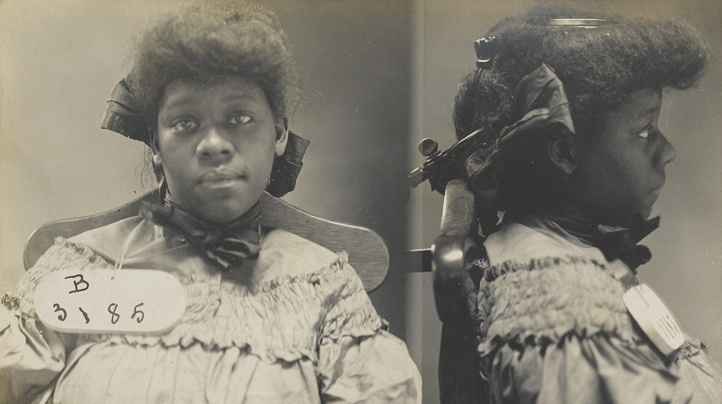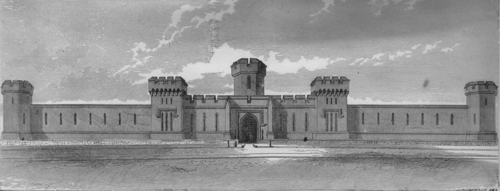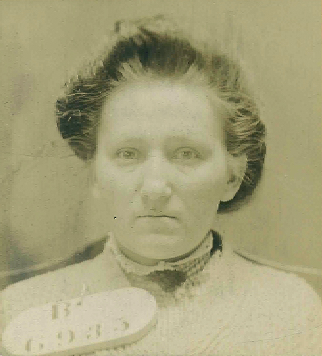Damon McCool (Specialist, Research and Public Programming) and Erica Harman (Manager, Archives and Records), Eastern State Penitentiary Historic Site

Essie Pollett (B-3185). Eastern State Penitentiary of Pennsylvania. Eastern State Penitentiary: Mug Shot Book 1904-1906. 1906. Eastern State Penitentiary Historic Site, gift of the Scheerer Family.
For more than half of Eastern State Penitentiary’s 142-year history (1829-1971), women as well as men were incarcerated within the 11-acre complex. In particular, Black women experienced disproportionate rates of incarceration compared to their White peers. The experience of women living in an institution designed for men highlights the social and political tensions of the 19th and early 20th centuries. The dramatic increase in the number of women in prisons today illuminates the challenges facing 21st century prison reformers.
Between 1831 and 1923, more than 900 women served time at Eastern State. While this is less than three percent of Eastern State’s estimated population during that time, women made a substantial impact on the institution.

Façade. Annual report of the Inspectors of the State Penitentiary for the Eastern District of Pennsylvania for the year 1910. 81, Eastern State Penitentiary, 1911.
The first two female prisoners, Amy Rogers (No. 73) and Henrietta Johnson (No. 74), arrived at Eastern State on April 30, 1831—less than two years after Eastern State opened. Both women were sentenced for manslaughter. Early on, women lived on the gallery of Cellblock 7. Later, they inhabited Cellblock 2. Though kept separate, male and female prisoners sometimes made contact.
The letters of Elizabeth Elwell (No. 4587) to Albert Jackson (No. 4227), now housed at the American Philosophical Society, stand out as rare examples of interactions between a male and female prisoner as well as a glimpse into an incarcerated woman’s perspective during the 19th century. The letters, passed clandestinely throughout the penitentiary in the spring of 1862, describe secret meetings with Jackson, Elwell’s feelings toward him and her feelings about Eastern State which she described as a “house of bondage.” Most other sources that describe incarcerated people and their experiences at Eastern State were written by men in positions of authority.
While it seems that Elwell and Jackson’s correspondence remained undetected until after their release, women, like men, got in trouble for breaking the rules and disrespecting prison officers. Margaret Brown (B-3131) was punished for “being saucy to the day matron” and throwing a piece of soap at her, according to the warden’s journal. [1] At least 29 women arrived at Eastern State pregnant and gave birth during their incarceration. Essie Pollett (B-3185) gave birth at Eastern State and kept her infant with her for six months. A fellow prisoner, Laura Irons (B-2904), paroled before Pollett, took the baby and cared for her until Pollett was released. [2] During her incarceration in the early 1920s, Bertha Kimball (C-1137) was brought to an outside hospital to give birth. She and her baby, Kenneth, returned to Eastern State to continue her sentence. Upon meeting baby Kenneth, the warden gave him a one-dollar bill. [3]

Freda Frost (B-6935). Eastern State Penitentiary of Pennsylvania. Eastern State Penitentiary: Bertillon Cards. 1913. Eastern State Penitentiary Historic Site.
Officials transferred all female prisoners out of the building in 1923. Most were sent to Muncy, a newly opened women’s facility that is still an active prison. Freda Frost (B-6935), incarcerated for the poisoning death of her husband, was the last woman transferred out.
After 1923, a few women still arrived at the penitentiary, but they were transferred immediately to women’s facilities. Laura Fellis (C-9698), sentenced for an abortion that resulted in the death of a young woman, was processed and photographed at Eastern State in 1934.
Today, women are the fastest growing segment of the U.S. prison population. Women are more likely to be imprisoned for drug and property offenses, while men are more likely to be imprisoned for violent offenses. [4] Why do you think that is? Women live within a prison system largely designed for men, though they often require specialized healthcare and facilities. One in 25 women in state prisons is pregnant upon admission. [5] How do you think prisons can best support female prisoners?
For more information about women and prisons today, see the Incarcerated Women and Girls Fact Sheet from the Sentencing Project as well as resources provided by The Prison Policy Initiative. Lastly, check out Dehanza Rogers’ video projection project #BlackGirlhood at Eastern State Penitentiary Historic Site.
[1] Eastern State Penitentiary of Pennsylvania. Eastern State Penitentiary: Wardens’ Daily Journals (Roll 6611). June 7, 1906. Pennsylvania Department of Justice.
[2] Eastern State Penitentiary of Pennsylvania. Eastern State Penitentiary: Wardens’ Daily Journals (Roll 6611). March 31, 1907. Pennsylvania Department of Justice.
[3] Eastern State Penitentiary of Pennsylvania. Eastern State Penitentiary: Cellblock 2 Logbook. July 11, 1922. Eastern State Penitentiary Historic Site, gift of the family of John D. Shearer.
[4] Carson, E. Ann, Ph.D, Emily Buehler, Stephanie Mueller, Danielle Kaeble, and Todd Minton. "Prisoners in 2019." Prisoners in 2019. Bureau of Justice Statistics, Oct. 2020. Web. 17 Sept. 2021. <https://bjs.ojp.gov/content/pub/pdf/p19.pdf>
[5] Sufrin, Carolyn, et al. “Pregnancy Outcomes in US Prisons, 2016-2017.” American journal of public health vol. 109, 5 (2019): 799-805. doi:10.2105/AJPH.2019.305006